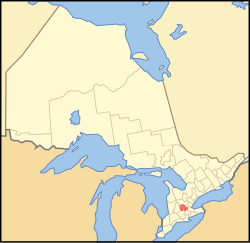Waterloo Region | |
|---|---|
| Regional Municipality of Waterloo | |
Clockwise: Kitchener City Hall, Waterloo Regional Headquarters, Grand River scene in Cambridge, aerial view of St. Jacobs, University of Waterloo Nano Centre | |
| Motto(s): "Peace, Prosperity!" | |
 Location of Waterloo Region in Ontario | |
| Coordinates: 43°29′35″N 80°30′04″W / 43.49306°N 80.50111°W[1] | |
| Country | Canada |
| Province | Ontario |
| Seat | Kitchener |
| Government | |
| • Regional Chair | Karen Redman |
| • Governing Body | Waterloo Regional Council |
| • MPs | List of MPs |
| • MPPs | List of MPPs |
| Area | |
| • Land | 1,370.07 km2 (528.99 sq mi) |
| Population (2021)[2] | |
| • Total | 587,165 |
| • Density | 428.6/km2 (1,110/sq mi) |
| GDP | |
| • Tri-Cities CMA | CA$32.9 billion (2020)[3] |
| Time zone | UTC−5 (EST) |
| • Summer (DST) | UTC−4 (EDT) |
| Area code(s) | 519, 226, 548 |
| Website | region |
The Regional Municipality of Waterloo (Waterloo Region or Region of Waterloo) is a metropolitan area of Southern Ontario, Canada. It contains the cities of Cambridge, Kitchener and Waterloo (KWC or Tri-Cities), and the townships of North Dumfries, Wellesley, Wilmot and Woolwich. Kitchener, the largest city, is the seat of government.
The region is 1,370 square kilometres (530 sq mi) in area, with a population of 587,165 as of the 2021 Canada census,[2] though an end of 2023 estimate puts the population above 673,910 people.[4] Waterloo Region forms the tenth-largest metropolitan area in Canada, with recent population growth almost entirely fuelled by international students.[4] In 2016, the Kitchener-Waterloo-Cambridge area was rated Canada's third-best area to find full-time employment.[5]
The region was formerly called Waterloo County, created in 1853 and dissolved in 1973. The county consisted of five townships: North Dumfries, Waterloo, Wellesley, Wilmot, and Woolwich.
- ^ "Regional Municipality of Waterloo". Geographical Names Data Base. Natural Resources Canada.
- ^ a b c Cite error: The named reference
2021censuswas invoked but never defined (see the help page). - ^ "Statistics Canada. Table 36-10-0468-01 Gross domestic product (GDP) at basic prices, by census metropolitan area (CMA) (x 1,000,000)". Statistics Canada.
- ^ a b "Waterloo Region says international students behind big population boost". Kitchener. 7 May 2024. Retrieved 17 June 2024.
- ^ "Canada's best cities for full-time jobs". globalnews.ca. 14 January 2017. Retrieved 22 March 2018.






